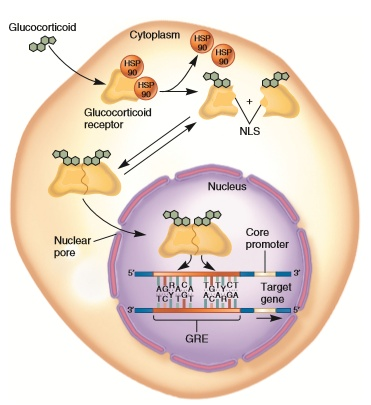
Genetics: Analysis and Principles 4th Edition by Robert Brooker
Edition 4ISBN: 978-0077474904
Genetics: Analysis and Principles 4th Edition by Robert Brooker
Edition 4ISBN: 978-0077474904 Exercise 16
Solved problem S3 shows the locations of domains in the glucocorticoid receptor relative to the amino- and carboxyl-terminal ends of the protein. Make a drawing that illustrates the binding of a glucocorticoid receptor dimer to the DNA. In your drawing, label the amino and carboxyl ends, the hormone-binding domains, the DNA-binding domains, the dimerization domains, and the transactivation domains.
Problem S3
To gain a molecular understanding of how the glucocorticoid receptor works, geneticists have attempted to "dissect" the protein to identify smaller domains that play specific functional roles. Using recombinant DNA techniques described in Chapter 20, particular segments in the coding region of the glucocorticoid receptor gene can be removed. The altered gene can then be expressed in a living cell to see if functional aspects of the receptor have been changed or lost. For example, the removal of the portion of the gene encoding the carboxyl-terminal half of the protein causes a loss of glucocorticoid binding. These results indicate that the carboxyl-terminal portion contains a domain that functions as a glucocorticoid-binding site. The following figure illustrates the locations of several functional domains within the glucocorticoid receptor relative to the entire amino acid sequence.
Based on your understanding of the mechanism of glucocorticoid receptor function described in Figure 15.7, explain the functional roles of the different domains in the glucocorticoid receptor.
FIGURE 15.7 The action of glucocorticoid hormones. Once inside the cell, the glucocorticoid hormone binds to the glucocorticoid receptor, releasing it from a heat shock protein known as HSP90. This exposes a nuclear localization signal (NLS). Two glucocorticoid receptors then form a dimer and travel into the nucleus, where the dimer binds to a glucocorticoid response element (GRE) that is next to a particular gene. The binding of the glucocorticoid receptors to the GRE activates the transcription of the adjacent target gene.
Problem S3
To gain a molecular understanding of how the glucocorticoid receptor works, geneticists have attempted to "dissect" the protein to identify smaller domains that play specific functional roles. Using recombinant DNA techniques described in Chapter 20, particular segments in the coding region of the glucocorticoid receptor gene can be removed. The altered gene can then be expressed in a living cell to see if functional aspects of the receptor have been changed or lost. For example, the removal of the portion of the gene encoding the carboxyl-terminal half of the protein causes a loss of glucocorticoid binding. These results indicate that the carboxyl-terminal portion contains a domain that functions as a glucocorticoid-binding site. The following figure illustrates the locations of several functional domains within the glucocorticoid receptor relative to the entire amino acid sequence.

Based on your understanding of the mechanism of glucocorticoid receptor function described in Figure 15.7, explain the functional roles of the different domains in the glucocorticoid receptor.
FIGURE 15.7 The action of glucocorticoid hormones. Once inside the cell, the glucocorticoid hormone binds to the glucocorticoid receptor, releasing it from a heat shock protein known as HSP90. This exposes a nuclear localization signal (NLS). Two glucocorticoid receptors then form a dimer and travel into the nucleus, where the dimer binds to a glucocorticoid response element (GRE) that is next to a particular gene. The binding of the glucocorticoid receptors to the GRE activates the transcription of the adjacent target gene.

Explanation
The diagram shows the Glucocorticoid rec...
Genetics: Analysis and Principles 4th Edition by Robert Brooker
Why don’t you like this exercise?
Other Minimum 8 character and maximum 255 character
Character 255



